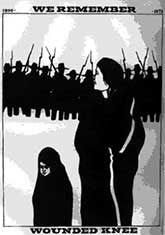 The American Indian Movement’s (AIM) best known and most controversial protest began in February 1973 in Wounded Knee, South Dakota, a small town on the Pine Ridge reservation. Wounded Knee Two began as a conflict within the Oglala Lakota (Sioux) tribe between the supporters of the tribal Chairman Richard Wilson and other tribal members who considered him to be a corrupt puppet of the Bureau of Indian Affairs (BIA).
The American Indian Movement’s (AIM) best known and most controversial protest began in February 1973 in Wounded Knee, South Dakota, a small town on the Pine Ridge reservation. Wounded Knee Two began as a conflict within the Oglala Lakota (Sioux) tribe between the supporters of the tribal Chairman Richard Wilson and other tribal members who considered him to be a corrupt puppet of the Bureau of Indian Affairs (BIA).Like many other such conflicts, it had simmered for a while. In 1973, the disagreements between the two segments of the Pine Ridge Lakota Sioux created so much anger and division that both sides ended up arming themselves. The forces allied with Wilson, along with Federal law enforcement officials and U.S. military, entered into a 71-day siege of the AIM forces.
The AIM group included local citizens, national AIM members, prominent entertainment figures, and members of national philanthropic, religious, and legal organizations. National news organizations covered the entire 71 days of the siege and its aftermath.
When the siege ended on May 9, 1973, two Native American members of AIM were dead and an unknown number were wounded on both sides. Richard Wilson remained in office and was challenged in the next election. Many AIM members spent the next years in litigation, in exile, and in prison.
Several more armed conflicts erupted in the wake of the siege, in large part due to continuing counterintelligence programs and vigorous prosecutions that targeted AIM members. The most well-known of these cases is that of Leonard Peltier who remains in prison because of an at-best questionable conviction in the death of an FBI agent in 1975.
Although I was living in Germany at the time, the occupation came close to home. A classmate of mine whose family was connected to Pine Ridge left his senior year in early March to participate. His father was supportive, despite his rather contradictory role as part of the U.S. Army’s infantry. Indeed, it is likely that while he was in Vietnam he participated in campaigns named after earlier military actions against his own people.
No comments:
Post a Comment